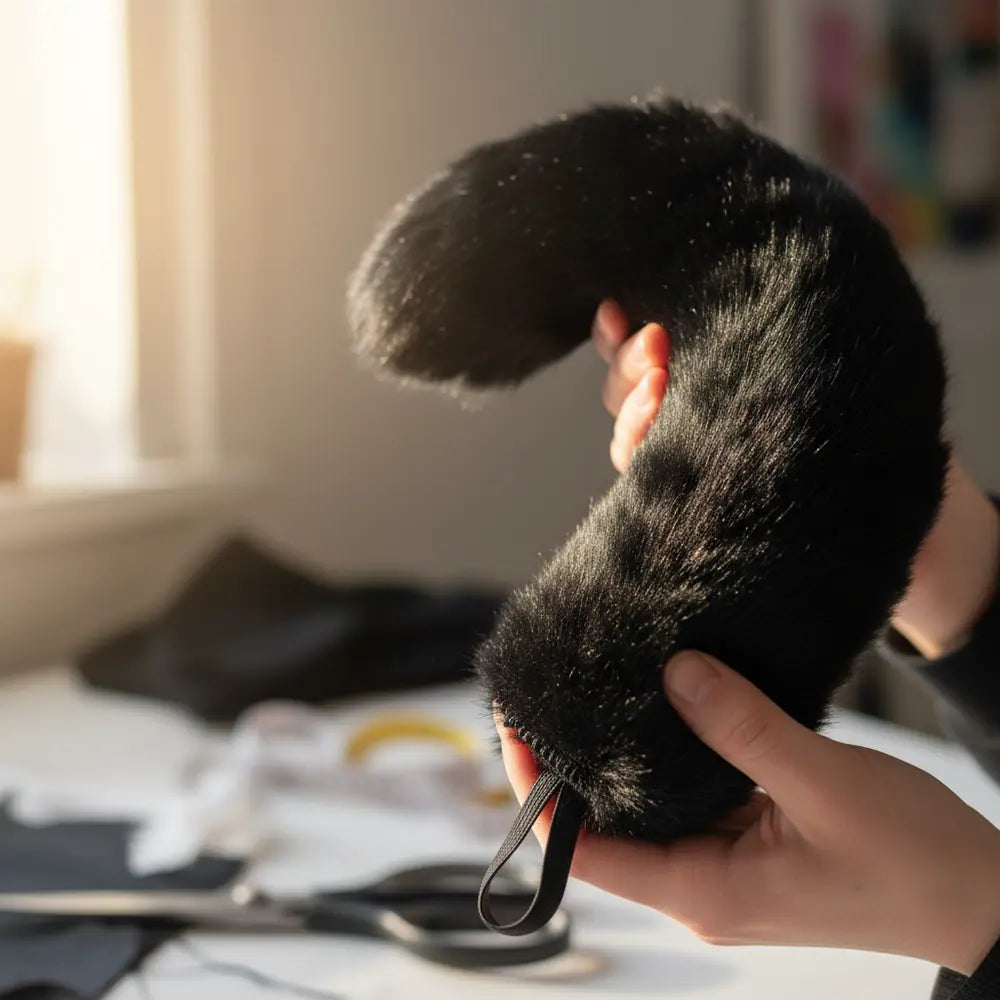
DIY Handmade Cat Tail: Step-by-Step Guide
DIY Handmade Cat Tail: Step-by-Step Guide
Ever spent weeks planning the perfect cosplay, only to be let down by the accessories? You search online for a cat tail and find options that are overpriced, disappointingly flimsy, or just not the right color. It's a common frustration that can make an amazing costume feel incomplete. What if you could create a high-quality, custom cat tail for a fraction of the cost?
This guide empowers you to do just that. Making your own handmade cat tail is not only budget-friendly but also a deeply rewarding creative process. You get complete control over the size, shape, color, and feel, ensuring your cat tail cosplay accessory is truly one-of-a-kind.
We’ll walk you through everything, from picking your materials to sewing the final stitch. This tutorial is designed for absolute beginners, breaking down each stage into simple, easy-to-follow instructions. Get ready to craft an accessory that brings your character to life.
Why Make Your Own Handmade Cat Tail?
Wondering if the effort of a DIY project is really worth it? This section breaks down the clear advantages of creating your own tail, from saving money to unlocking your creative potential.
Making your own costume pieces is a core part of the cosplay and DIY community spirit. A DIY cat tail is the perfect entry point. It’s a small, manageable project that teaches you valuable skills you can apply to more complex creations later.
The most obvious benefit is the cost. A quick search on Etsy reveals that custom-made tails can range from $50 to over $150, depending on the complexity and materials. By sourcing the supplies yourself, you can easily make a beautiful, durable tail for under $25. That's a huge saving that can be put toward other parts of your costume.
Beyond the savings is the power of customization. You are no longer limited to what's available in stores. You choose the exact shade of faux fur, the precise length and curl, and the specific texture. This is your chance to create an accessory that perfectly matches your vision, whether it’s for a specific character or an original design.
Materials & Tools Checklist
Feeling overwhelmed by the aisles of the craft store? This checklist simplifies your shopping trip, clearly outlining exactly what you need and why.
Gathering your supplies is the first exciting step. You don't need a professional sewing studio—just a few basic items will do the trick. The key is choosing materials that fit your vision and skill level.

Your Cat Tail Supply List
- Fabric (about 1/2 yard): Choose faux fur, felt, fleece, or minky.
- Stuffing: A standard bag of polyester fiberfill (like Poly-Fil).
- Optional Wire: 12 or 14-gauge craft wire for a poseable tail.
- Basic Sewing Kit: Strong thread, needles, fabric scissors, marker, and pins.
A common misconception is that you need an expensive sewing machine. For this project, a simple needle and thread are more than enough. In fact, a hand sewn cat tail cosplay accessory often has stronger, more precise seams.
Preparing Your Pattern
Think you can't draw a straight line, let alone a pattern? This section shows you how to create a perfect tail template in minutes, no artistic skill required.
Your pattern is the blueprint for your tail. Don't worry, it's incredibly simple to create. The classic cat tail shape is essentially a long, gently curved tube that tapers at the end.

How to Draft the Pattern
- Determine Your Length: Decide how long you want your tail to be. A good starting point is to measure from your lower back to your ankles. For a shorter, bouncier tail, aim for the back of your knees.
- Draw the Shape: On a large piece of paper (or directly onto the back of your fabric with chalk), draw a long, slightly curved shape, like a skinny banana. Make the base about 4-5 inches wide and taper it down to a soft point at the tip.
- Add Seam Allowance: This is a crucial step! Trace a second line about a half-inch outside your first line. This extra space is where you will sew, ensuring your finished tail isn't too thin.
Tips for Cutting Faux Fur
If you're using faux fur, here is a pro-level tip that changes everything. Never use scissors to cut through the fur pile. Instead, flip the fabric over and use a craft knife or box cutter to only slice through the backing fabric. This technique prevents you from giving your fur a "bad haircut," keeping the edges fluffy and natural-looking.
Step-by-Step Sewing Instructions
Feeling a little nervous about that first stitch? We'll break down the entire sewing process into small, manageable actions, guiding you from flat fabric to a fully formed tail.
This is where your creation starts to take shape. Take your time, and remember that even messy stitches on the inside will be hidden from view. The goal is a strong, durable seam.
Sewing the Seam
Worried you don't know the right kind of stitch? This part teaches you the one simple, strong stitch you'll need for this and many other DIY projects.
With your fabric cut out, fold it in half lengthwise with the "right" sides (the furry or pretty sides) facing each other. Pin the long, curved edge together to hold it in place. The straight edge at the base should remain open.
The best stitch for hand-sewing is the backstitch. It creates a line of thread that looks almost identical to a machine stitch and is incredibly strong.
- Start Your Stitch: Push your threaded needle through the fabric from the inside, about a half-inch from the edge (your seam allowance).
- Go Backward: Make a small stitch backward from where the thread came up.
- Go Forward: Push the needle up again, a little bit ahead of your first stitch.
- Repeat: Go backward again to meet the end of your last stitch. Continue this "two steps forward, one step back" motion all the way down the seam.
Turning and Stuffing
Ever get a project stuck while trying to turn it right-side out? Here’s a simple trick to make this frustrating step incredibly easy.
Once your seam is sewn, it’s time for the magical reveal. Turning a long, thin tube of fabric can be tricky, but a simple tool makes it easy. Grab a chopstick, a knitting needle, or the unsharpened end of a pencil.
Push the tool into the sewn tip of the tail from the outside. Then, gently start feeding the fabric down over the tool, turning the tail right-side out as you go. Be patient and work slowly to avoid stressing the seams.
Now, stuff your tail. A common mistake is adding large clumps of stuffing, which creates a lumpy look. Instead, pull off small handfuls of fiberfill and push them down to the tip one by one. Continue until the tail is firmly and evenly filled.
Adding Wire for Poseability
Is your tail suffering from the "limp noodle" effect? This section explains how to add a simple wire skeleton to give it life and a dynamic, poseable shape.
A floppy tail can look lifeless. Adding a wire is the secret to achieving that perfect, expressive "S" curve. This step is optional but highly recommended for a more professional-looking cat tail cosplay accessory.

- Prepare the Wire: Cut a piece of craft wire that is a few inches longer than your tail.
- Safety First: Use pliers to curl both ends of the wire into small, tight loops. This is critical to prevent the sharp ends from eventually poking through your fabric.
- Insert the Skeleton: Gently guide the wire into the center of your stuffed tail. The loops will help it slide through the fiberfill.
- Secure the Base: Bend the extra length of wire at the base of the tail into a flat loop or spiral. Tuck this inside and add a final bit of stuffing to hold it in place.
Which style of cat tail would you make?
Perfecting the Attachment
Worried your beautiful new tail will sag, droop, or fall off mid-con? We’ll cover three reliable methods to attach your handmade cat tail securely and comfortably.
How you attach the tail is just as important as how you make it. A poor attachment can ruin the illusion and become a constant annoyance. We'll cover three easy and secure methods. Before attaching, finish the open base of the tail by folding the raw edges inward and sewing them shut with a simple whipstitch.
The Belt Loop Method
Looking for the most versatile and secure way to wear your tail? The belt loop method is the gold standard for cosplay and is surprisingly easy to create.
This is the most common and reliable method. You create fabric loops on the base of the tail that a belt can slide through.
- Create the Loops: Cut two small rectangular pieces from your leftover fabric, about 2 inches by 3 inches.
- Sew the Loops: Fold each rectangle in half (pretty side out) and sew the long edge to create a small tube.
- Attach to Tail: Hand-sew the ends of each tube securely to the base of your tail, creating two sturdy loops. Space them a few inches apart for stability.
This method anchors the tail directly to your body over your clothes, providing excellent movement and support.
The Safety Pin Method
Need a quick and easy attachment for a last-minute costume? The safety pin method is your best friend, but there's a right way to do it.
For a fast, no-sew attachment, safety pins are a great option. However, one small pin won't cut it. The key is to use multiple large, heavy-duty safety pins to distribute the weight.
For the most secure and hidden application, pin from the inside of your garment. Push the pin through the clothing, through the reinforced base of the tail, and back through the clothing. Use at least two or three pins for a tail of average weight to prevent sagging and tearing.
The Waist Tie Method
Wearing a dress or leggings with no belt? The waist tie method offers an elegant and integrated solution that becomes part of the costume itself.
This method is perfect for outfits without a waistband or belt loops. It involves sewing long ties directly onto the base of the tail, which you can then tie around your waist.
Use a sturdy ribbon or create your own ties from the same fabric as your tail for a seamless look. Sew them securely to the top corners of the tail's base. You can wear the ties over your clothes for a cute bow detail or hide them underneath for a more mysterious look.
Troubleshooting & Common Mistakes
Did your project hit a snag or not turn out quite right? Don't worry—this section addresses the most common crafting mishaps and provides simple, effective fixes.
Even seasoned crafters make mistakes. The good news is that most problems with a DIY cat tail are easily fixable. Don't get discouraged! Let's walk through the most common issues and how to solve them.
-
Problem: My seams are splitting!
Cause: This usually happens when stitches are too far apart or if you used a simple running stitch instead of a stronger backstitch. It can also occur if the tail is overstuffed, putting too much pressure on the seams.
Solution: If the split is small, you can fix it from the outside with a ladder stitch. For a bigger issue, it's best to turn the tail inside-out again and re-sew the entire seam with smaller, tighter backstitches. -
Problem: The tail looks lumpy and uneven.
Cause: This is almost always caused by using large chunks of stuffing instead of small, consistent pieces.
Solution: This is tedious but worth it. Use your chopstick to reach inside and break up the large clumps. If it's really bad, you may need to pull some stuffing out and re-stuff it more carefully. Remember, small, fluffy pieces are the key to a smooth finish. -
Problem: My tail is a "sad noodle"—it's totally limp!
Cause: The tail is either under-stuffed or is missing a supportive core. A purely stuffed tail will naturally have a gentle droop.
Solution: First, try adding more stuffing, packing it in firmly. If that doesn't give you the shape you want, it's time to add a wire skeleton as described in the previous section. This is the single best fix for a floppy tail and is what gives a cat tail cosplay accessory its dynamic, lifelike quality. -
Problem: The attachment point is sagging or tearing my costume.
Cause: The weight of the tail is concentrated in one small spot. A single safety pin or a weak, narrow belt loop will almost always fail.
Solution: Reinforce and distribute the weight. If using pins, switch to two or three heavy-duty pins. If using loops, ensure they are made from durable fabric and sewn on securely across a wide area of the tail's base.
Feeling more confident in your crafting skills? Once you master this basic design, a world of creative possibility opens up. To take your crafting to the next level, explore our detailed guide on Unique Handmade Cat Tail Ideas for 2025 for advanced styles and next-level inspiration.
Creative Variations & Inspiration
Ready to move beyond the basic black cat and make something truly unique? Let's explore some creative ideas to make your handmade tail a showstopper.
Your first DIY cat tail is a fantastic accomplishment. Now, you can use that foundation to create accessories for any theme imaginable. The only limit is your imagination.
-
Themed Tails: Think beyond a single color. Use fabric markers to add stripes for a Cheshire Cat, or sew on spots for a snow leopard. For a Halloween costume, a skeletal tail can be made by sewing black felt "bones" onto a white tail.
-
Plush vs. Realistic: For a cute, "chibi" or kawaii style, make your tail shorter, thicker, and use ultra-soft minky fabric. For a more realistic look, use high-quality faux fur and study the shape and movement of real felines. A Realistic Rainbow Faux Fur Cat Tail is a popular choice that blends fantasy with a natural shape.
-
Festival Fun: Add embellishments! Weave in battery-powered LED fairy lights for a magical glow at night. Sew on small jingle bells for a playful sound, or tie colorful ribbons and charms along the length for a festive flair. This is a huge trend in festival crafts.
The trend of expressive, animal-inspired accessories is growing. It's not just about static props anymore; enthusiasts are exploring new ways to bring characters to life. This includes everything from custom tails to animated accessories. Curious about the technology behind some of the most innovative cosplay gear? Dive into our explanation of what moving cat ears are and how they work.
Your Crafting Journey Begins
You've learned how to transform simple materials into a fully customized handmade cat tail. From drafting a pattern and choosing the right fabric to mastering the backstitch and creating a secure attachment, you now have the skills to build a core piece of any costume. You've seen how a few simple fixes can solve common problems and how a little creativity can make your project truly unique.
Now it's time to put that knowledge into action. Don't be afraid to experiment and make it your own. Your first creation is a stepping stone.

We'd love to see what you create!
Share a photo of your finished DIY cat tail on social media and tag us to be featured!
Download Sharing GuideAnd if you're curious about what other animal accessories are trending, you might be surprised to see how fox tails are becoming a fashion statement outside of conventions. Learn more by reading our article, From Anime Con to Everyday: Why Fox Tails Are Trending.
For more cosplay tutorials and DIY craft guides, be sure to subscribe to our newsletter!
Frequently Asked Questions
1. How long does it take to make a DIY cat tail?
For a beginner, a hand-sewn cat tail will likely take about 2-4 hours. This includes gathering materials, creating the pattern, sewing, and stuffing. An experienced sewer might complete the project in under 90 minutes.
2. What's the best fabric for a total beginner?
Felt is the most beginner-friendly fabric. It's inexpensive, comes in many colors, and its edges don't fray, which means you don't have to worry about messy seams. Fleece is another great, soft option that is very forgiving to sew.
3. Can I make a no-sew handmade cat tail?
Yes, you can make a no-sew version using a strong fabric glue. Instead of sewing the seam, you would apply a thin, even layer of fabric glue along the seam allowance, press the sides together, and let it cure completely according to the glue's instructions before turning and stuffing.
4. How do I wash my handmade cat tail?
You should always spot-clean your tail first with a damp cloth and mild soap. If it has a wire inside, do not submerge it in water or put it in a washing machine. For a tail with only stuffing, you can hand wash it gently in cool water and let it air dry completely. Use a brush to fluff the fur back up once it's dry.




